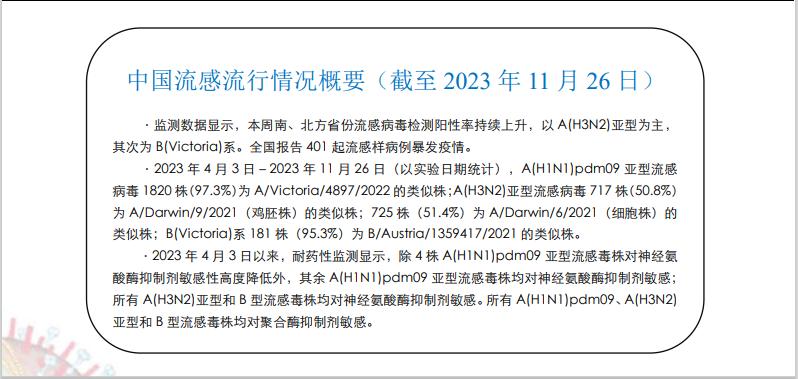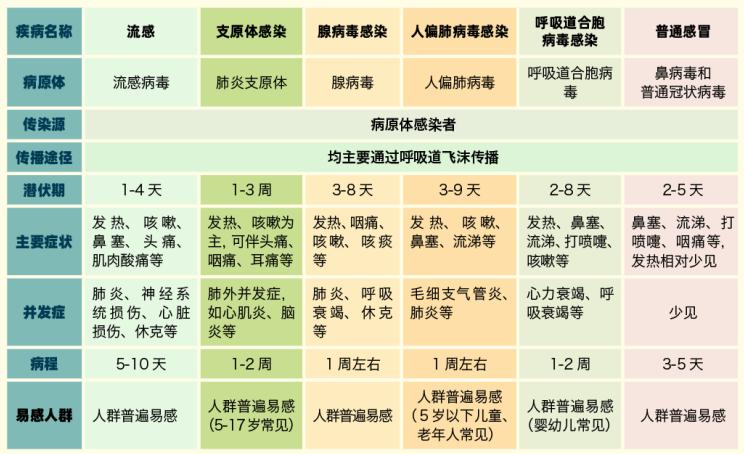present
In winter, the temperature is changeable, hot and cold.
Respiratory infectious diseases such as influenza
Enter the high season
According to the press conference of the National Health and Wellness Committee, at present, with the continuous winter in various places, respiratory diseases have entered a period of high incidence. Monitoring shows that influenza is the main infectious disease of respiratory tract recently. In addition, there are rhinovirus, mycoplasma pneumoniae, respiratory syncytial virus, adenovirus and so on.

Image source: National Influenza Center
Recent monitoring in Guangzhou shows that acute respiratory infectious diseases mainly caused by influenza and mycoplasma pneumoniae are active, and respiratory infections caused by rhinovirus, adenovirus, respiratory syncytial virus and other common respiratory pathogens are intertwined. In particular, the level of influenza activity has increased significantly. At present, influenza A (H3N2 subtype) and influenza B (Victoria strain) are prevalent at the same time, and influenza is gradually entering the winter epidemic period.

Image source: City Special Search
How to judge which pathogen is infected?
Influenza, Mycoplasma pneumoniae
And respiratory syncytial virus infection.
Symptoms such as cough and fever will appear.
How to distinguish?
Guangzhou CDC recently released
Health reminder
The clinical manifestations of respiratory infectious diseases are usually not specific, and there are individual differences among patients, so it is difficult to identify them clearly only by symptoms and signs. The diagnosis of which pathogen infection depends on laboratory tests, such as nucleic acid PCR detection and rapid antigen detection.
Popular in China at present
Several respiratory infectious diseases
These characteristics and similarities and differences

In daily life
How to prevent respiratory diseases scientifically?
Wash your hands frequently.
Wash your hands with soap or hand sanitizer and flowing water. Cover your mouth and nose with a handkerchief or paper towel when sneezing or coughing to avoid polluting your hands and the surrounding environment.
Multiple ventilation
Keep the indoor air circulating, and generally ventilate 2-3 times a day at home in winter for about 30 minutes each time.
Less aggregation
During the epidemic of infectious diseases in winter and spring, try not to go to crowded places and avoid contact with patients with respiratory diseases. It is recommended to wear masks when you need to go.
Drink plenty of water
Keep the nasal mucosa moist, effectively resist the invasion of viruses, and also facilitate the excretion of toxins in the body and purify the environment in the body.
A balanced diet and proper exercise.
Enhance your physical fitness (outdoor activities should be reduced in foggy days).
vaccination
Vaccine is an effective means to prevent related infectious diseases. For infectious diseases such as influenza, chickenpox and mumps, susceptible people can be prevented by vaccination in advance.
Hospitalization or rest at home
Once infected with infectious diseases in winter and spring, patients should take hospitalization or rest at home according to their illness and doctor’s advice, and avoid participating in group activities and entering public places during this period. Resume daily activities such as going to school and going to work after it is not contagious.
Warm reminder:
In order to meet everyone’s medical needs
Published by Guangzhou Municipal Health and Wellness Commission
Original title: "Guangzhou CDC: At present, these two viruses are popular at the same time! 》
Read the original text